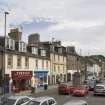Musselburgh, High Street, Mercat Cross
Market Cross (18th Century)
Site Name Musselburgh, High Street, Mercat Cross
Classification Market Cross (18th Century)
Alternative Name(s) Market Cross, Musselburgh
Canmore ID 53814
Site Number NT37SW 164
NGR NT 34629 72739
Datum OSGB36 - NGR
Permalink http://canmore.org.uk/site/53814
- Council East Lothian
- Parish Inveresk (East Lothian)
- Former Region Lothian
- Former District East Lothian
- Former County Midlothian
NT37SW 164 3463 7273
The Burgh Cross stands some 30m E of the Town House. From a square pedestal three steps rise to a Tuscan shaft of the late 18th century supporting a lion and the burgh arms.
RCAHMS 1929; C McWilliam 1978.
(Former index no. 1214). Descheduled.
Information from Historic Scotland, Certificate of Exclusion from Schedule dated 18 March 2009.
Field Visit (25 October 1920)
Musselburgh Cross.
The Burgh Cross stands some 30 yards east of the Town House. From a square pedestal with a moulded cornice three steps rise to a Tuscan column bearing on its abacus a lion sejant affronté supporting a cartouche charged with the Burgh Arms, three mussels. The cross is probably contemporary with the later wing of the Town House.
RCAHMS 1929, visited 25 October 1920.
OS map: iv S.E. (unnoted).
Publication Account (1996)
This particular cross dates back only to the middle decades of the eighteenth century, but is symbolic of the primary function of a burgh- as a market. The earlier cross, or crosses, may not have stood in precisely this spot, as it is known that the market cross was moved in 1774, after the demolition of Mid Row (see p 39), but it is likely to have been close by, as it would have stood near to the other important structure of urban life - the tolbooth.
Information from ‘Historic Musselburgh: The Archaeological Implications of Development’ (1996).






















